A strong company messaging strategy is the backbone of effective communication with your audience. It's the key to standing out in a crowded market and building lasting connections with customers.
At Cajabra, LLC, we've seen firsthand how a well-crafted messaging approach can transform a business. This guide will walk you through the essential steps to develop a compelling strategy that resonates with your target audience and drives results.
Who Is Your Target Audience?
Uncover Demographics and Psychographics
Understanding your audience forms the bedrock of an effective messaging strategy. Start by collecting concrete data about your ideal customers. Tools like Google Analytics or social media insights can reveal age ranges, locations, and income levels. The American Institute of CPAs is transforming its peer review program for firms' accounting and auditing engagements into a technology-driven process, which could provide valuable insights for tailoring your message.

Move beyond surface-level data to explore psychographics - the values, interests, and pain points of your audience. Conduct surveys or interviews with your best clients. Ask about their challenges, goals, and what they value most in a service provider. This qualitative data proves invaluable for crafting messages that truly resonate.
Examine Your Competitors' Approach
Take a close look at how your competitors communicate. Visit their websites, sign up for their newsletters, and follow their social media. Pay attention to the language they use, the benefits they highlight, and the overall tone of their messaging.
For example, if you notice that most competitors focus solely on tax services, you might find an opportunity to differentiate by emphasizing year-round financial planning. Tools like SEMrush or Ahrefs can provide insights into competitors' keywords and content strategies, helping you identify gaps in the market.
Define Your Unique Value Proposition
With a clear understanding of your audience and competitors, you can now articulate what sets you apart. Your unique value proposition (UVP) should address a specific need of your target market that competitors aren't fully meeting.
For accounting firms, this might involve specializing in a niche industry, offering cutting-edge technology solutions, or providing exceptional customer service. Whatever it is, make sure it's something you can consistently deliver and that truly matters to your audience.
Align with Your Company's Core
Ensure your messaging strategy aligns with your company's values and long-term goals. If your firm values innovation, your messaging should reflect that through language about new technologies or forward-thinking approaches.
Consider creating a simple one-page document that outlines your company's mission, vision, and core values. Use this as a reference point when developing your messaging to maintain consistency and authenticity.
Now that you've laid the groundwork by understanding your ideal client's needs, it's time to craft your core message. This next step will help you distill your insights into clear, compelling communication that resonates with your target market.
How to Craft a Powerful Core Message
Develop a Clear Brand Statement
Your brand statement should encapsulate what you do, who you serve, and why you're different in one or two sentences. For example: "We provide innovative tax solutions for small businesses, leveraging AI to maximize deductions and minimize audit risk." This statement clearly defines the service, target audience, and unique approach.
A study by the Content Marketing Institute found that 58% of B2B marketers say content marketing helped them generate sales/revenue in the last 12 months, up from 42% the previous year. This underscores the importance of articulating your core message.
Create a Distinctive Brand Voice
Your brand voice should reflect your firm's personality and resonate with your target clients. Are you authoritative and professional? Friendly and approachable? Tech-savvy and innovative? Define 3-5 key characteristics that describe your brand's tone.
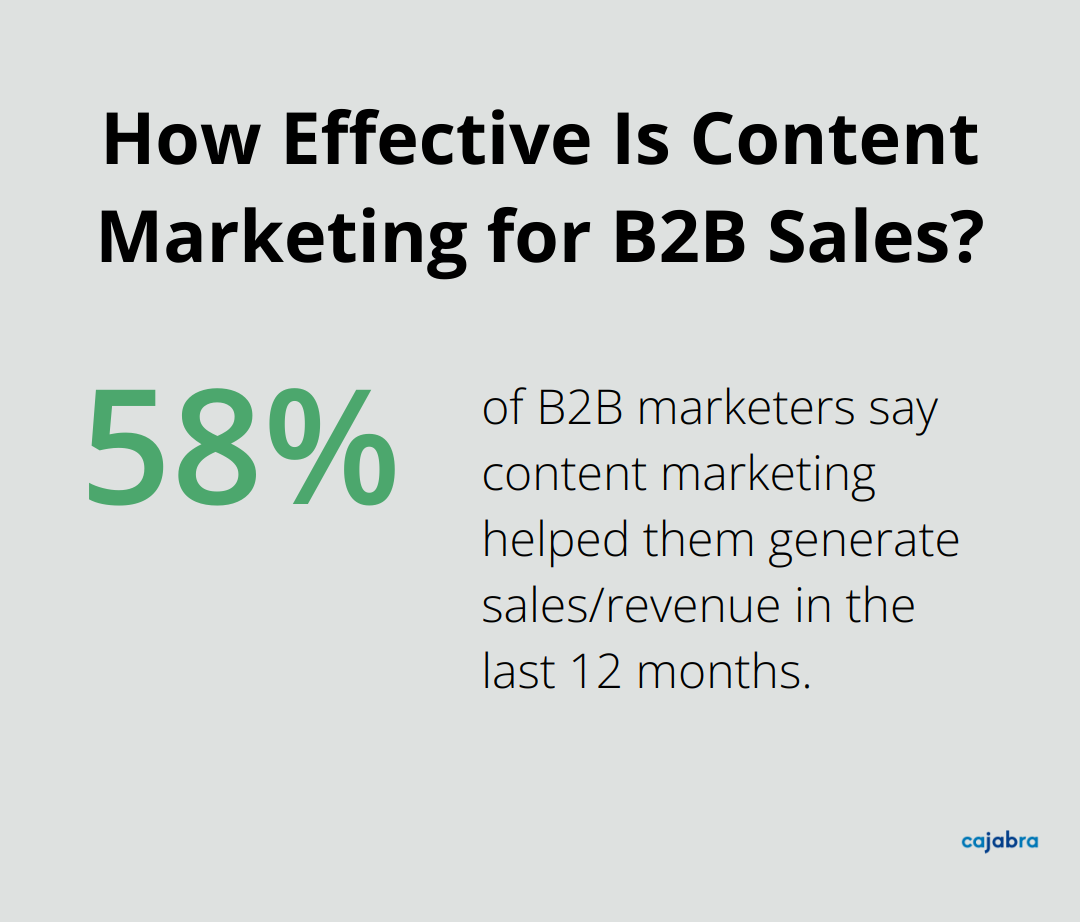
For instance, if you target startups, your voice might be "innovative, energetic, and straightforward." This would translate into using more dynamic language and focusing on cutting-edge solutions in your communications.
Identify Key Messaging Pillars
Select 3-4 main themes that support your brand statement. These could include your expertise in a specific industry, your use of advanced technology, or your personalized client approach. Each pillar should address a key pain point or desire of your target audience.
For example, if serving small businesses is a pillar, you might focus on messages about cost-effective solutions, scalable services, and deep understanding of small business challenges. The Journal of Accountancy reports that proactive strategic advice was ranked as the third-highest factor small and medium-size business owners consider when selecting a CPA.
Tailor Your Message Across Platforms
Different platforms require different approaches. LinkedIn might call for more professional, detailed content, while Twitter demands concise, punchy messages. Your website should offer comprehensive information, while email newsletters might focus on timely updates and tips.
A study by HubSpot found that companies using three or more channels in their marketing campaigns saw a 287% higher purchase rate than those using single-channel campaigns. This highlights the importance of adapting your core message across various touchpoints.
Your core message isn't set in stone. You should regularly review and refine it based on client feedback and market changes. The most effective messaging strategies evolve with your firm and your clients' needs. Now that you've crafted your powerful core message, it's time to put it into action. The next chapter will guide you through implementing and testing your messaging strategy to ensure maximum impact.
How to Implement Your Messaging Strategy Effectively
Train Your Team for Consistent Delivery
The first step in implementing your messaging strategy is to ensure your entire team understands and can effectively communicate your core messages. Conduct comprehensive training sessions that go beyond simply sharing new guidelines. Engage your staff in role-playing exercises where they practice delivering key messages in various scenarios, from client consultations to networking events.
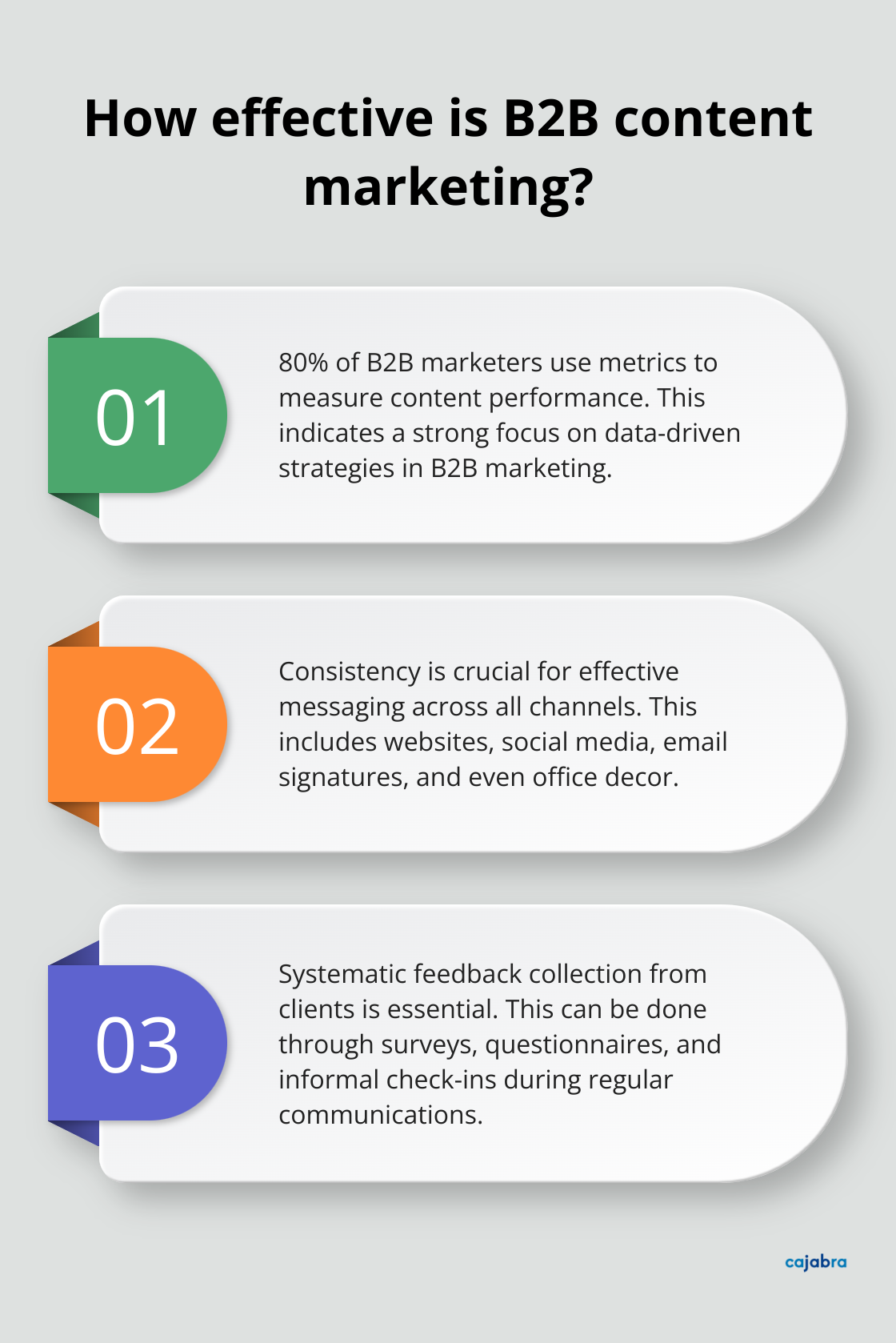
Create a centralized resource hub where team members can easily access messaging guidelines, brand voice examples, and frequently asked questions. This could be a shared drive or an internal wiki. Update this resource regularly based on real-world interactions and feedback.
Integrate Messaging Across All Channels
Consistency is key when it comes to effective messaging. Audit all your existing marketing materials and client touchpoints to ensure they align with your new strategy. This includes your website, social media profiles, email signatures, brochures, and even your office decor.
Develop a content calendar that outlines how your key messages will be communicated across different channels over time. For example, if one of your messaging pillars is expertise in AI-driven tax solutions, plan a series of blog posts, social media updates, and email newsletters that showcase this capability.
Test and Refine Your Approach
Once your messaging is live, it's important to measure its effectiveness. Implement A/B testing on your website and email campaigns to see which variations of your message resonate most with your audience. Tools like Google Optimize or Optimizely can help you set up these tests easily.
Monitor key performance indicators (KPIs) that align with your messaging goals. These might include website conversion rates, email open rates, or the number of inquiries about specific services. Four out of five B2B marketers use metrics to measure content performance.
Collect and Act on Client Feedback
Your clients are the ultimate judges of your messaging effectiveness. Implement a systematic approach to gathering their feedback. This could include short surveys after client meetings, annual satisfaction questionnaires, or even informal check-ins during regular communications.
Pay close attention to the language clients use when describing your services. If it aligns with your messaging, you're on the right track. If not, it may indicate areas where your message isn't getting through effectively.
Implementing a messaging strategy is an ongoing process. The most successful firms continuously refine their approach based on data and feedback. Follow these steps and stay attuned to your audience's needs to create a messaging strategy that truly resonates and drives results.
Final Thoughts
A company messaging strategy forms the cornerstone of effective communication with your target audience. It requires careful planning, execution, and continuous refinement to create a resonant approach. Your strategy should evolve with your firm and clients' needs, adapting to performance metrics, feedback, and market shifts.
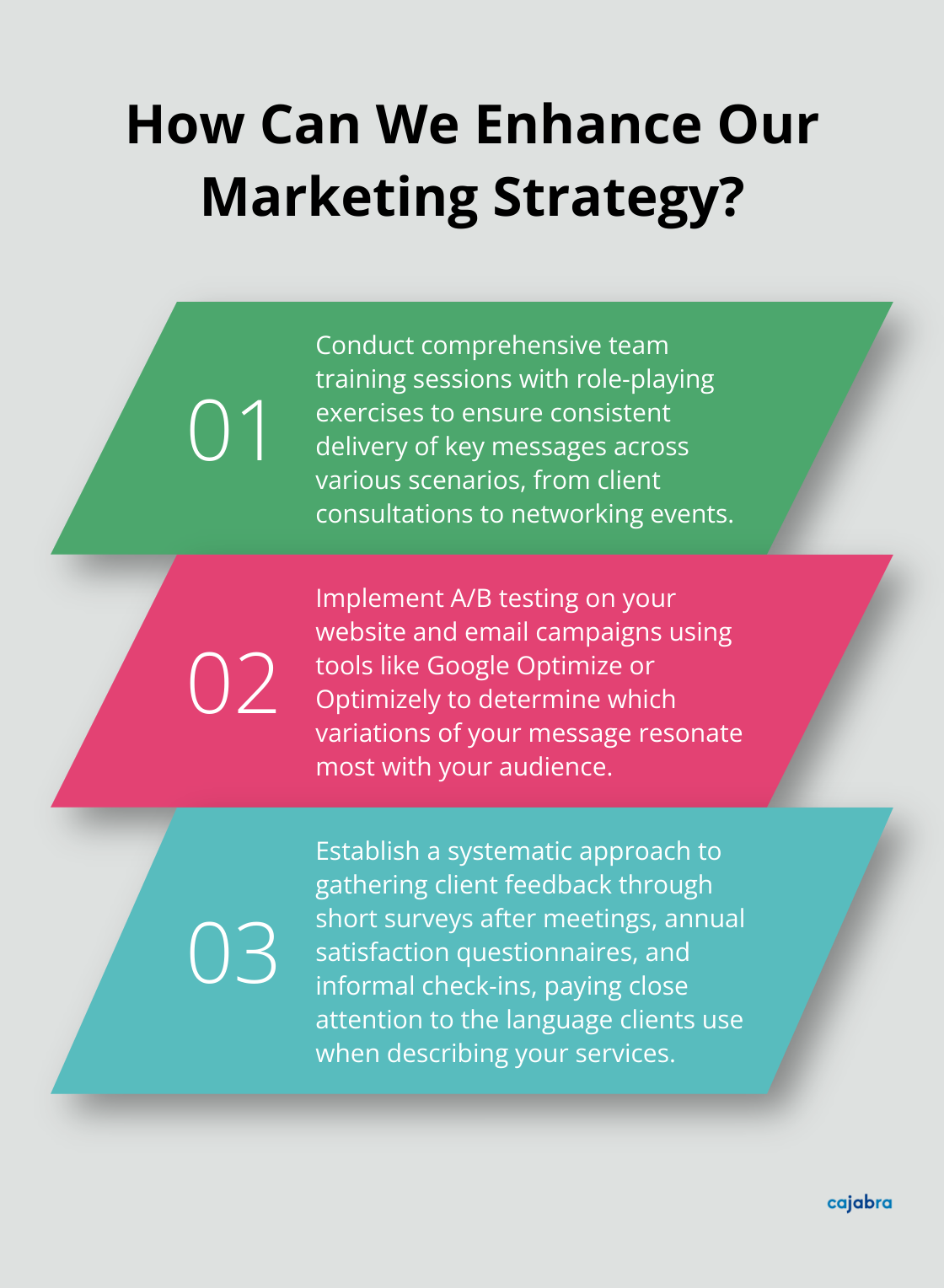
A well-crafted messaging strategy can transform your firm from overlooked to overbooked. It builds brand recognition, attracts clients, and fuels long-term growth. Your message acts as your voice in the market, making it essential to ensure it's heard loud and clear.
At Cajabra, we specialize in helping accountants develop and implement powerful messaging strategies that drive results. Our JAB System™ and marketing services can help you create a distinctive brand identity and generate high-quality leads. If you're ready to elevate your firm's messaging, explore how we can help you achieve your goals.
At Cajabra, LLC, we know that a strong key messaging strategy is the backbone of effective brand communication.
Your brand's voice is more than just words; it's the essence of your company's identity and values.
In this post, we'll guide you through the process of crafting compelling key messages that resonate with your audience and set your brand apart.
What Is Key Messaging?
The Foundation of Brand Communication
Key messaging forms the core of your brand's communication strategy. It's a set of carefully crafted statements that convey your brand's value, purpose, and unique selling points to your target audience. These messages act as the foundation for all your marketing efforts, ensuring consistency across various channels (from your website to social media posts and client presentations).
Driving Revenue Through Consistency
A study by Lucidpress revealed that consistent branding can increase revenue by up to 33%. This statistic underscores the significant impact that cohesive messaging can have on your bottom line. When your key messages align across all touchpoints, you create a unified brand experience that resonates with your audience and builds trust.
Shaping Brand Perception
Your key messages play a pivotal role in shaping how your audience perceives your brand. They help differentiate you from competitors and position your firm as the go-to expert in your field. For instance, a clear, compelling message that communicates a unique value proposition (such as moving accountants from overlooked to overbooked in just 90 days) immediately sets a firm apart in the minds of potential clients.
Guiding Internal Communication
Effective key messaging extends beyond external communication. It serves as a guide for your team, ensuring everyone aligns on how to talk about your firm's services and values. This internal alignment proves essential for delivering a consistent brand experience. Gallup's research has shown that companies with engaged workforces have higher earnings per share.
Evolving with the Market
Key messaging requires regular review and refinement to stay relevant in a changing market. As you develop your key messages, consider how they reflect your firm's core values, address your clients' pain points, and differentiate you in the industry. The most effective messages are clear, concise, and resonate deeply with your target audience.

Now that we've established what key messaging is and why it matters, let's explore how to develop powerful key messages that will set your brand apart.
How to Craft Powerful Key Messages
Know Your Audience Inside Out
The first step in developing impactful key messages is to understand your target audience. Conduct thorough market research to identify your ideal clients' demographics, pain points, and aspirations. For accounting firms, this might involve surveying existing clients, analyzing industry trends, and studying competitor messaging.
A recent study found that 72% of customers will share a positive experience with 6 or more people. This underscores the importance of tailoring your messages to address specific client needs and preferences.
Align with Your Brand's Core
Your key messages should directly reflect your brand's values and mission. Start by revisiting your company's mission statement and core values. For instance, if your accounting firm values transparency and innovation, your key messages should emphasize these qualities.
Keep It Clear and Compelling
Clarity is key when you craft your messages. Avoid industry jargon and complex terms that might confuse your audience. Instead, focus on simple, powerful statements that clearly communicate your value proposition.

For example, instead of saying "We provide comprehensive financial solutions," you could say "We help small businesses save time and money on taxes." The latter is more specific and addresses a direct benefit to the client.
Test and Refine
Once you draft your key messages, it's important to test them with your target audience. This can be done through focus groups, surveys, or A/B testing in your marketing campaigns.
A report revealed that leaders who say service and marketing are highly aligned are 69% more likely to say that their customer service strategy was effective in 2023. Testing and refining your messages based on audience feedback ensures they truly resonate with your target market.
Adapt and Evolve
Developing key messages is an ongoing process. As your business evolves and market conditions change, your messaging should adapt accordingly. Try to review and update your key messages regularly (at least annually) to ensure they remain relevant and effective in driving your brand's success.
Now that you've learned how to craft powerful key messages, let's explore how to implement these messages across various channels to maximize their impact. Creating a brand voice guide that outlines your tone, language, and key messages can help ensure consistency across all team members involved in customer communication.
How to Implement Your Key Messages
Infuse Your Marketing Materials
Start with an audit of all your existing marketing materials. This includes your website, brochures, social media profiles, and email templates. Update these materials to reflect your new key messages consistently. For example, if one of your key messages emphasizes your firm's expertise in tax-saving strategies for small businesses, feature this message prominently on your homepage and in your email signatures.
Train Your Team
Your staff are your brand ambassadors. Conduct regular training sessions to ensure everyone understands and can articulate your key messages effectively. Create a messaging strategy that includes your key messages, along with examples of how to use them in different scenarios (from client meetings to networking events).

A report by Gallup states that companies with engaged workforces have higher earnings per share (EPS) and seem to have recovered from the recession more quickly. Aligning your team with your key messages not only improves communication but also boosts overall performance.
Tailor for Different Platforms
While your core messages should remain consistent, adapt how you deliver them to different platforms. On LinkedIn, share detailed insights that showcase your expertise. On Instagram, use visual infographics to convey the same message more effectively. On Twitter, use concise, punchy statements.
Measure and Optimize
Implementing key messages requires ongoing attention. Use analytics tools to track how your messages perform across different channels. Monitor metrics like engagement rates, click-throughs, and conversions. If a message doesn't resonate on a particular platform, tweak it or try a different approach.
Consistency Across Channels
Maintain consistency in your key messages across all channels. This consistency builds trust and recognition with your audience. Try to create a unified brand experience, whether a potential client encounters your firm on social media, your website, or through a personal interaction with a team member.
Plan Your Strategies
To effectively implement your key messages, plan your marketing communication strategies. Define your target market, position your products, and develop a clear plan for disseminating your messages across various channels.
Final Thoughts
Key messaging strategy forms the foundation of effective brand communication. It shapes audience perception, drives consistency across touchpoints, and impacts your bottom line. Clear, compelling messages that resonate with your target audience will set your accounting firm apart in a crowded market.
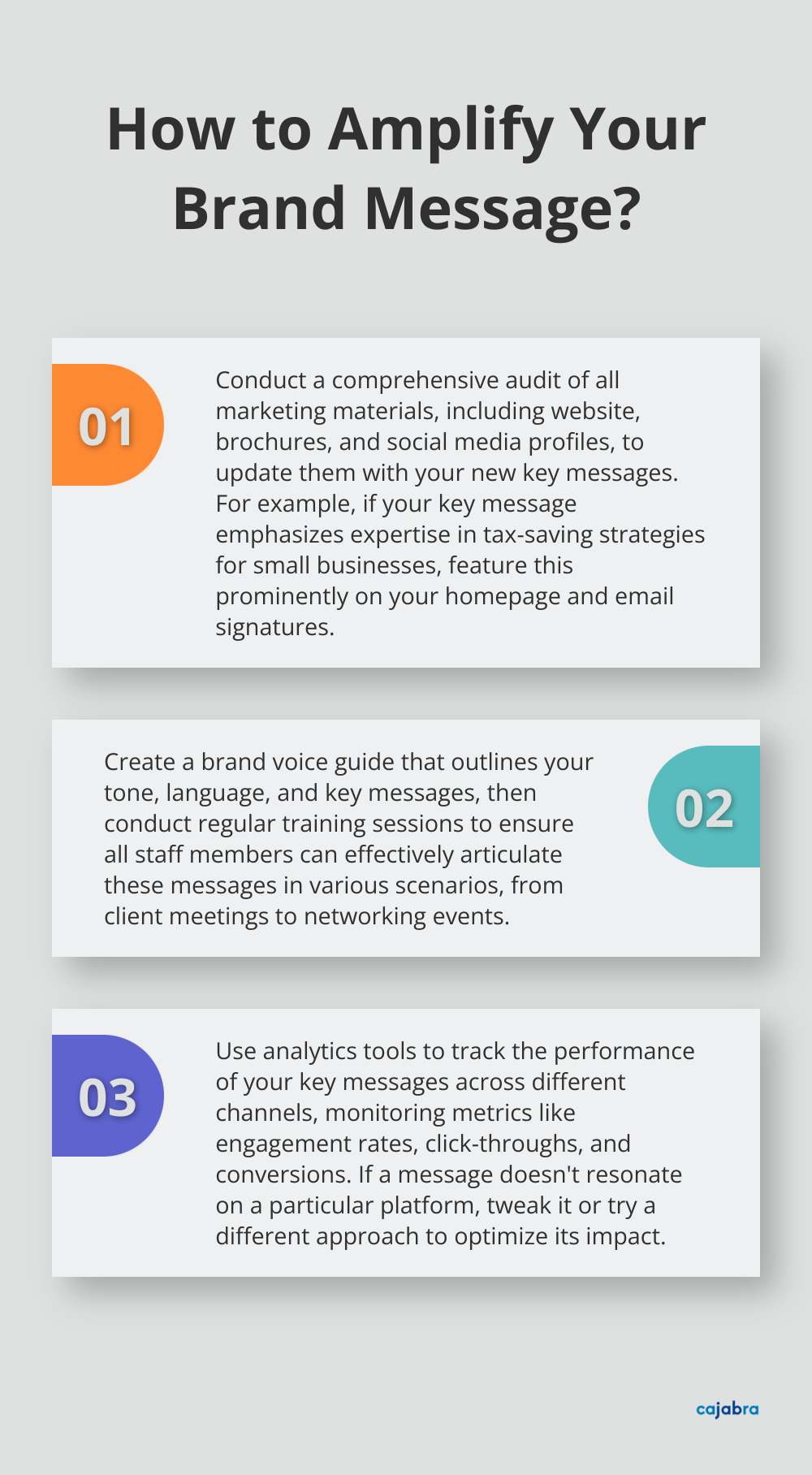
A well-executed messaging strategy offers numerous benefits (including team alignment and client trust). It helps you adapt to changing market conditions while staying true to your core values. Your key messages require regular review and adjustment to maintain their effectiveness.
At Cajabra, we help accounting firms develop powerful messaging strategies that move them from overlooked to overbooked. Our JAB System™ secures retainer-based clients and positions your firm as an industry leader. Take the first step towards transforming your brand communication today.
At Cajabra, LLC, we know that effective communication is the cornerstone of any successful brand. But what is a messaging strategy, and why does it matter?
A well-crafted messaging strategy serves as the foundation for all your brand's communications, ensuring consistency and impact across every touchpoint. In this post, we'll explore how to develop and implement a powerful messaging strategy that resonates with your audience and drives results.
What's Your Brand's Core Message?
Uncovering Your Unique Value
Your brand's core message forms the foundation of a powerful messaging strategy. To develop a message that resonates with your target audience and sets you apart, start by identifying what makes your brand different. For accounting firms, this could be specialized expertise, innovative technology, or exceptional customer service. A 2023 survey by Accounting Today revealed that 78% of clients choose their accountants based on industry-specific knowledge, highlighting the importance of showcasing your unique strengths.
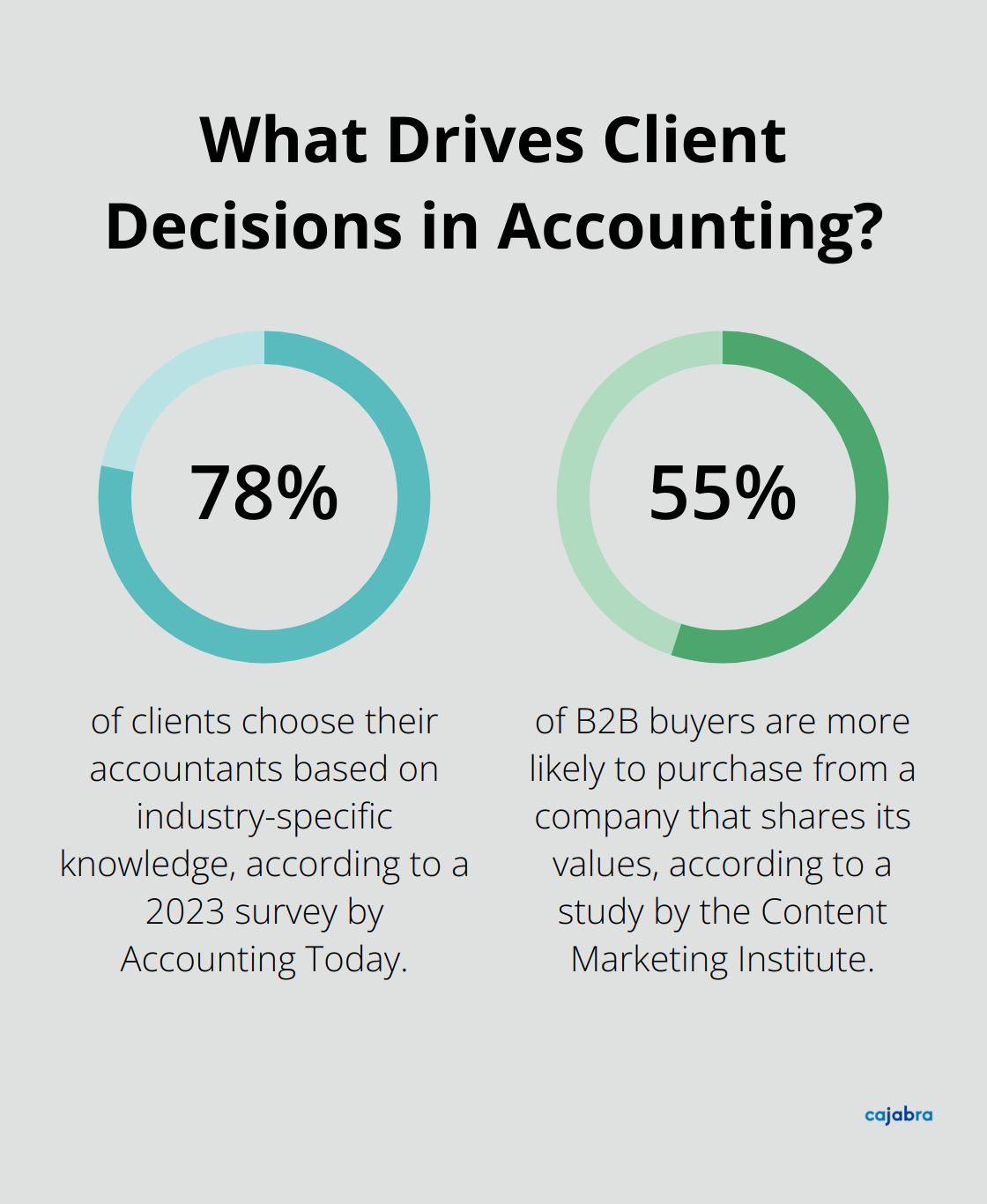
To uncover your unique value, analyze your services, client feedback, and market position. Look for patterns in client testimonials or reasons why clients prefer you over competitors. These insights will shape your core message.
Know Your Audience Inside Out
Understanding your target audience is essential. For accounting firms, this means identifying the specific industries or types of businesses you serve best. Focusing on one type of client can help CPA firms develop unique expertise that distinguishes them from their competition.
Create detailed profiles of your ideal clients. What are their pain points? What challenges do they face? For instance, many small business owners struggle with cash flow management. If you offer solutions to this problem, make it a key part of your messaging.
Crafting Your Brand Story
Your brand story should communicate your values, mission, and the impact you have on clients' lives. A study by the Content Marketing Institute found that 55% of B2B buyers are more likely to purchase from a company that shares its values.
When crafting your narrative, focus on the transformation you provide. Instead of saying "We offer tax preparation services," you could say "We help small businesses navigate complex tax laws, saving them time and money." This approach highlights the value you bring to your clients' businesses.
Keep your message clear and jargon-free. While you're an expert in accounting terms, your clients may not be. Use language that resonates with them and clearly communicates the benefits of working with your firm.
Aligning Your Message with Client Needs
Your core message should address the specific needs and challenges of your target audience. For example, if you specialize in serving small businesses, your message might emphasize how you help them grow and scale their operations. If you focus on high-net-worth individuals, your message could highlight your expertise in complex tax planning and wealth management.
Try to incorporate client testimonials or case studies that demonstrate the real-world impact of your services. This social proof can significantly strengthen your core message and make it more compelling to potential clients.
Differentiating Your Brand
In a competitive market, it's crucial to differentiate your brand from others. Your core message should clearly communicate what sets you apart. This could be your unique approach to client service, your use of cutting-edge technology, or your specialized expertise in certain industries.
For instance, if you're using AI-powered tools to enhance your services, make this a key part of your message. Highlight how this technology translates into better outcomes for your clients, whether it's more accurate financial forecasts or faster turnaround times.
A strong core message serves as the North Star for all your marketing efforts. It guides your content creation, social media strategy, and client interactions, ensuring a consistent and compelling brand presence across all channels. In the next section, we'll explore how to develop a consistent messaging framework that builds on this core message.
How to Build a Consistent Messaging Framework
Creating Key Messaging Pillars
A consistent messaging framework transforms an accounting firm's marketing efforts. Start by identifying 3-5 key messaging pillars that support your core message. These pillars should reflect your unique value proposition and address your clients' main pain points. For example, an accounting firm might focus on expertise, technology, personalized service, industry specialization, and proactive financial planning.
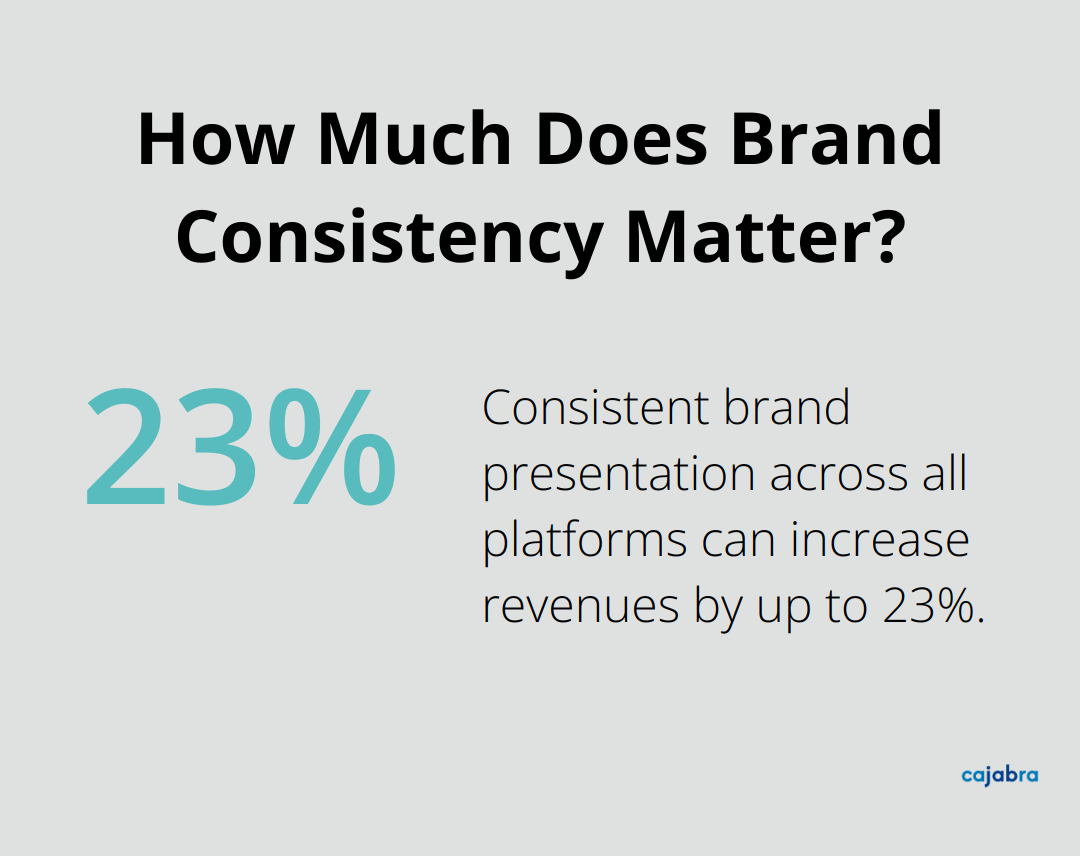
Each pillar should have specific proof points or examples. If technology is a pillar, highlight your use of cloud-based accounting software or AI-powered tax preparation tools. Be specific about how these technologies benefit your clients.
Tailoring Messages for Different Channels
Your core message remains consistent, but how you communicate it should adapt to different channels and audiences. A LinkedIn post targeting CFOs will differ from an email newsletter for small business owners.
For social media, keep messages concise and engaging. Twitter's character limit forces brevity, so focus on one key benefit or insight per tweet. On LinkedIn, you can explore industry trends or share thought leadership content more deeply.
Email marketing allows for more detailed communication. Segment your email list based on client types or industries, and tailor your messages accordingly. According to DMA, marketers have found a 760% increase in email revenue from segmented campaigns.
Your website should serve as a comprehensive resource, expanding on each messaging pillar with dedicated pages or sections. Use clear, benefit-focused headlines and support claims with case studies or client testimonials.
Establishing Brand Voice and Tone
Your brand voice is the personality you convey in your communications. For accounting firms, this often means striking a balance between professionalism and approachability. Your tone may vary slightly depending on the context, but should always align with your overall brand voice.
Create a simple guide that outlines your brand voice and provides examples of do's and don'ts. This guide might include:
-
Words to use (e.g., "proactive," "expert," "partner")
-
Words to avoid (e.g., "cheap," "basic," "complicated")
-
Tone descriptors (e.g., "confident but not arrogant," "helpful but not condescending")
Share this guide with everyone involved in creating content for your firm, from social media managers to partners writing thought leadership pieces.
Ensuring Consistency Across Platforms
Consistency is key in brand presentation. A report by Lucidpress shows that consistent brand presentation across all platforms can increase revenues by up to 23%. Try to maintain a unified look and feel across all your marketing materials, from your website to your social media profiles to your email signatures.
This consistency extends beyond visual elements to the language and messaging you use. Every piece of content should reinforce your key messaging pillars and reflect your brand voice. Regular audits of your marketing materials can help ensure this consistency.
As we move forward, we'll explore how to implement this messaging framework effectively across your organization and marketing efforts.
Putting Your Messaging Strategy into Action
Train Your Team Thoroughly
Your team forms the frontline of your brand communication. Every employee should understand and embody your messaging strategy. We recommend regular training sessions to ensure alignment across the organization.
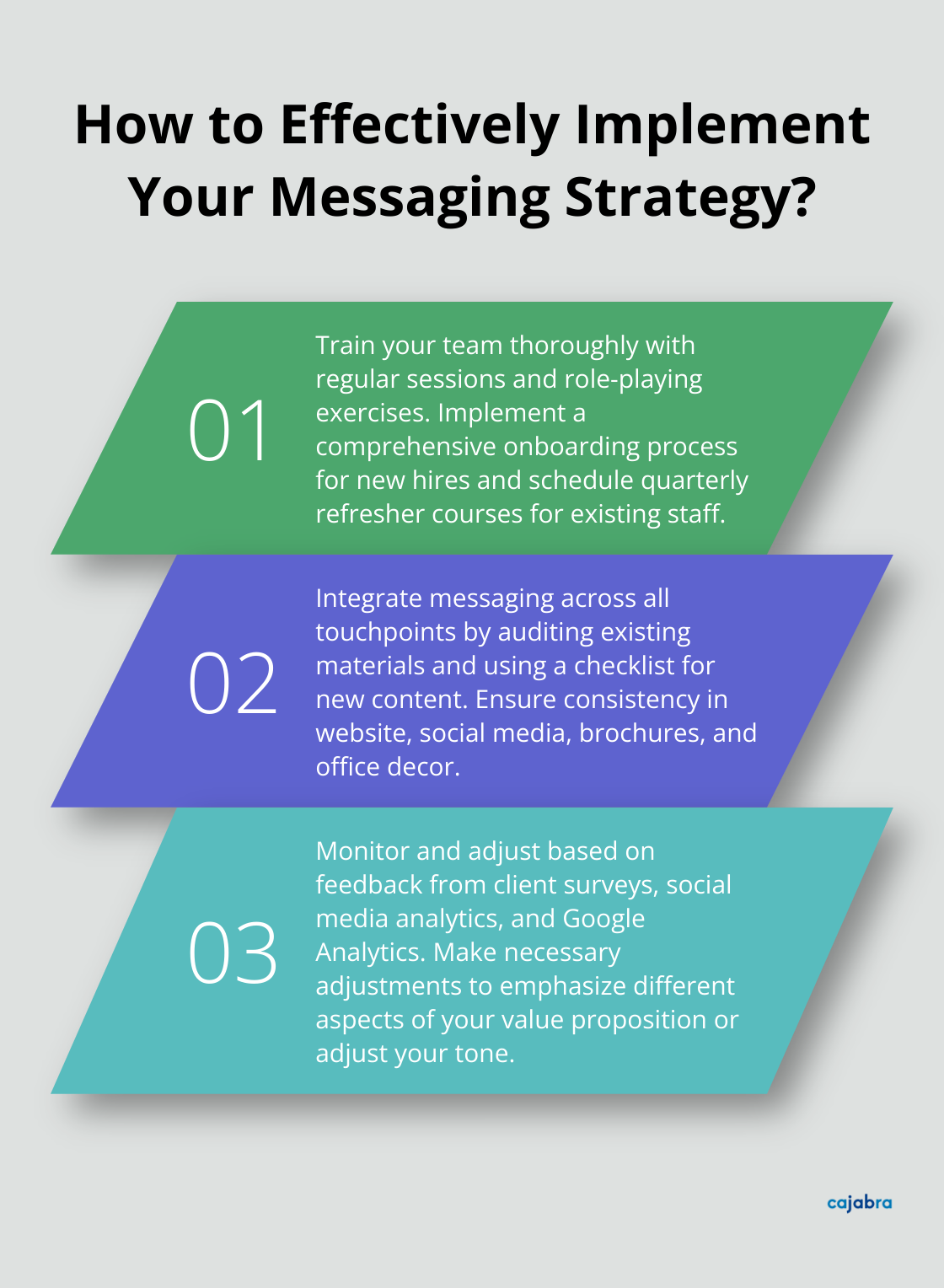
Implement a comprehensive onboarding process for new hires. This process should include an in-depth review of your messaging guidelines, brand voice, and key pillars. For existing staff, schedule quarterly refresher courses to keep the messaging strategy at the forefront.
Role-playing exercises prove particularly effective. These exercises include scenarios for practicing feedback in a supportive environment, building skills and confidence. Ask team members to practice communicating your value proposition in various scenarios (such as client meetings or networking events). This hands-on approach helps internalize the messaging and builds confidence in delivery.
Integrate Messaging Across All Touchpoints
Consistency plays a key role when implementing your messaging strategy. Every piece of content should reflect your core message and brand voice.
Start with an audit of all existing marketing materials. This audit should cover your website, social media profiles, brochures, and even office decor. Identify any inconsistencies and update them to align with your new messaging strategy.
For new content creation, use a checklist to ensure alignment with your messaging framework. This checklist should include questions like:
-
Does this content reflect our key messaging pillars?
-
Does the tone match our brand voice?
-
Does it address our target audience's pain points?
-
Have we included our unique value proposition?
Monitor and Adjust Based on Feedback
Your messaging strategy should evolve based on audience feedback and market changes. Implement a system to regularly gather and analyze feedback from various sources.
Client surveys provide valuable insights. Ask specific questions about how well your messaging resonates with them. For example, "How well do you feel we understand your business challenges?" or "What aspects of our service do you find most valuable?"
Social media analytics reveal which messages resonate most with your audience. Pay attention to engagement rates on different types of posts. If posts about your technology solutions get more traction than those about your industry expertise, consider adjusting your messaging emphasis.
Google Analytics uncovers which pages on your website perform best. If your "Services" page has a high bounce rate, it might indicate that your messaging doesn't clearly communicate your offerings.
Based on this data, make necessary adjustments. You might need to emphasize a different aspect of your value proposition or adjust your tone to better connect with your audience.
Leverage Technology for Consistent Messaging
Technology can help maintain consistency in your messaging across various platforms. Consider using tools like content management systems (CMS) or customer relationship management (CRM) software to centralize your messaging assets and ensure all team members have access to the most up-to-date information.
Some CMS platforms allow you to create templates with pre-approved messaging elements, making it easier for team members to create on-brand content. CRM systems can help personalize your messaging for different client segments, ensuring that each communication aligns with your overall strategy while addressing specific client needs.
Measure the Impact of Your Messaging Strategy
To truly understand the effectiveness of your messaging strategy, establish key performance indicators (KPIs). These might include metrics such as website conversion rates, client acquisition costs, or client retention rates.
Regularly review these KPIs to assess the impact of your messaging strategy. If certain metrics don't improve as expected, it may indicate areas where your messaging needs refinement.
Final Thoughts
A strong messaging strategy forms the backbone of effective brand communication. We explored what a messaging strategy is and why it matters for accounting firms in a competitive market. You create a powerful brand identity by defining your core message, developing a consistent framework, and implementing it across all touchpoints.

Your messaging strategy should evolve with your business and client needs. Regular reviews and refinements ensure your message remains relevant and impactful. Effective brand communication requires commitment and consistency from your entire team.
At Cajabra, we help accounting firms develop and implement powerful messaging strategies. Our JAB System™ moves accountants from overlooked to overbooked in just 90 days. If you want to elevate your firm's brand communication and attract more retainer-based clients, visit our website to learn how we can support your growth journey.
Effective messaging is the cornerstone of business growth in today's competitive landscape. At Cajabra, LLC, we've seen firsthand how the right communication strategy can transform a company's trajectory.
This post explores messaging strategy examples that have proven successful for businesses across various industries. We'll guide you through crafting compelling brand stories, leveraging multi-channel communication, and personalizing your approach to resonate with your target audience.
How to Craft Your Brand's Unique Story
Uncover Your Unique Value Proposition
To identify your unique value proposition (UVP), start by analyzing your competitors. What do you offer that they don't? For example, Cajabra developed the JAB System™, recognizing a gap in the market for specialized marketing services tailored to accounting firms. This system became their UVP, promising to move accountants from overlooked to overbooked in just 90 days.
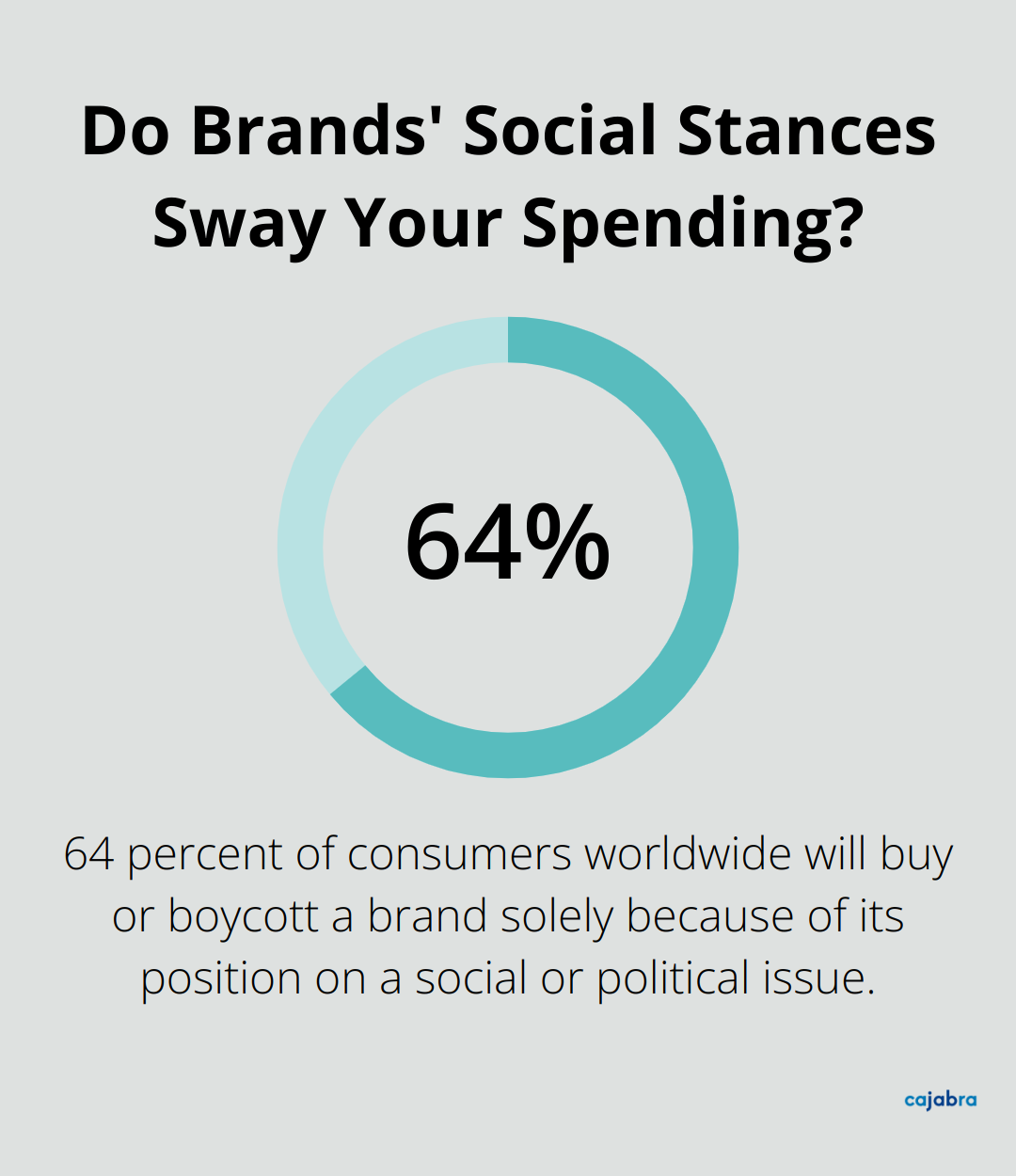
Next, survey your existing clients. Ask them why they chose your business over others. Their responses often reveal strengths you might have overlooked. A study by Edelman found that nearly two-thirds (64 percent) of consumers around the world will buy or boycott a brand solely because of its position on a social or political issue. This insight can help you align your UVP with your audience's values.
Maintain a Consistent Brand Voice
Once you've identified your UVP, communicate it consistently across all platforms. Create a brand voice guide that outlines your tone, language, and key messages. Share this guide with all team members involved in customer communication.
For instance, MailChimp's voice guide describes their tone as "plain-spoken, genuine, and dry," which perfectly aligns with their brand identity. This consistency has contributed to their growth to over 12 million active customers.
Forge Emotional Connections
Emotional connections drive customer loyalty. A study by the Harvard Business Review found that emotionally connected customers are more than twice as valuable as highly satisfied customers over their lifetime.
To create these connections, focus on storytelling. Share your company's origin story, highlight customer success stories, and showcase your team's personalities. Airbnb does this effectively through their "Stories from the Airbnb Community" series, which features real hosts and travelers, fostering a sense of belonging among their users.
Another powerful technique aligns your brand with a cause. TOMS Shoes built their entire brand around their "One for One" giving model, donating a pair of shoes for every pair purchased. This approach not only differentiated them in the market but also created a strong emotional bond with socially conscious consumers.
Your brand story isn't static. It should evolve with your company and your audience. Regularly revisit and refine your narrative to ensure it remains relevant and resonant. A compelling brand story that highlights your unique value, maintains consistency, and forges emotional connections creates a strong foundation for business growth.
Now that we've explored how to craft your brand's unique story, let's examine how to effectively communicate this story across multiple channels.
How to Maximize Your Multi-Channel Communication
Effective communication across multiple channels drives business growth in today's digital landscape. A well-executed multi-channel strategy boosts engagement and conversions significantly.
Tailor Your Message for Each Platform
Different platforms have unique characteristics and user behaviors. LinkedIn users expect professional content, while Instagram thrives on visual storytelling. According to The Sprout Social Index™ 2022, 73% of Gen Z consumers think it's important for brands to amplify their beliefs and values. This fact underscores the importance of adapting your message while maintaining brand consistency.

To tailor your message effectively:
- Understand the demographics and preferences of users on each platform
- Adapt your content style and format accordingly
- Maintain a consistent brand voice across all channels
For example, TikTok's user base (predominantly Gen Z, with 60% of users between 16-24 years old) responds well to short, entertaining videos with a casual tone. In contrast, Facebook's largest age group (25-34) suits more detailed content and community engagement.
Bridge Online and Offline Messaging
While digital channels dominate, offline messaging still plays a vital role in many industries. Create a seamless experience across all touchpoints. Starbucks exemplifies this approach with their mobile app that integrates with in-store purchases, creating a cohesive brand experience both online and offline.
For service-based businesses, blend digital and physical interactions. A law firm might use targeted social media ads to drive potential clients to book in-person consultations. This approach combines the reach of digital platforms with the personal touch of face-to-face meetings.
Use Data for Channel Optimization
Data-driven insights optimize your multi-channel strategy. Tools like Google Analytics reveal which channels drive the most traffic and conversions to your website. Social media platforms also offer robust analytics that help you understand engagement rates and audience demographics.
A McKinsey study found that companies using data-driven personalization delivered five to eight times the ROI on marketing spend. This finding highlights the importance of not just collecting data, but actively using it to refine your strategy.
To optimize your channels:
- Set clear KPIs for each channel (e.g., engagement rate, click-through rate, conversion rate)
- Review these metrics regularly
- Adjust your strategy based on the results
For instance, if your email campaigns have a higher conversion rate than your social media ads, allocate more resources to email marketing.
Effective multi-channel communication identifies the most impactful channels for your business and optimizes your presence on those platforms. The next chapter will explore how to personalize your messaging strategy to resonate with your target audience on a deeper level.
How to Personalize Your Messaging for Maximum Impact
Personalization is not a luxury in marketing-it's a necessity. A study by Epsilon found that 80% of consumers are more likely to make a purchase when brands offer personalized experiences. This chapter explores how you can implement personalization in your messaging strategy to drive business growth.
Segment Your Audience for Targeted Messaging
Effective personalization starts with segmentation. Divide your audience into groups based on shared characteristics such as demographics, behavior, or preferences. This allows you to tailor your messages to each group's specific needs and interests.

For example, a software company might segment its audience into small businesses, mid-sized companies, and enterprises. Each segment would receive messages highlighting features and benefits most relevant to their size and needs.
To implement segmentation:
- Analyze your customer data to identify common traits and behaviors
- Create distinct segments based on these insights
- Develop messaging strategies for each segment
Netflix uses viewing history to create micro-segments, allowing them to recommend shows with remarkable accuracy. This personalized approach has contributed to their impressive customer retention rate.
Create Detailed Buyer Personas
Buyer personas take segmentation a step further by creating fictional representations of your ideal customers. These detailed profiles help you understand your audience on a deeper level, allowing for more targeted and effective messaging.
To create effective buyer personas:
- Conduct customer interviews and surveys
- Analyze your website and social media analytics
- Gather insights from your sales and customer service teams
HubSpot's research shows that using marketing personas made websites more effective and easier to use by targeted users. This demonstrates the power of truly understanding your audience.
Leverage Dynamic Content for Relevance
Dynamic content adapts based on user data, behavior, or preferences. It's a powerful tool for delivering personalized experiences at scale.
For instance, an e-commerce site might show different homepage banners based on a user's browsing history. A first-time visitor might see a general welcome message, while a returning customer who previously viewed running shoes would see promotions for athletic gear.
Amazon excels at dynamic content, with product recommendations driving a significant portion of their revenue. Their "Customers who bought this item also bought" feature is a prime example of how dynamic content can boost sales through personalization.
To implement dynamic content:
- Identify key areas where personalization can make an impact (e.g., email subject lines, product recommendations)
- Use marketing automation tools to deliver personalized content based on user data
- Continuously test and refine your approach
Personalization is an ongoing process. You should regularly review your data and adjust your strategies to ensure your messaging remains relevant and effective. These personalization techniques will help you create more engaging, targeted messages that resonate with your audience and drive business growth.
Final Thoughts
Effective messaging strategies form the foundation of successful business growth. The examples we've explored, from crafting compelling brand stories to personalizing communication, play vital roles in connecting with audiences and driving results. These strategies help businesses stand out, build trust, and turn customers into loyal advocates.
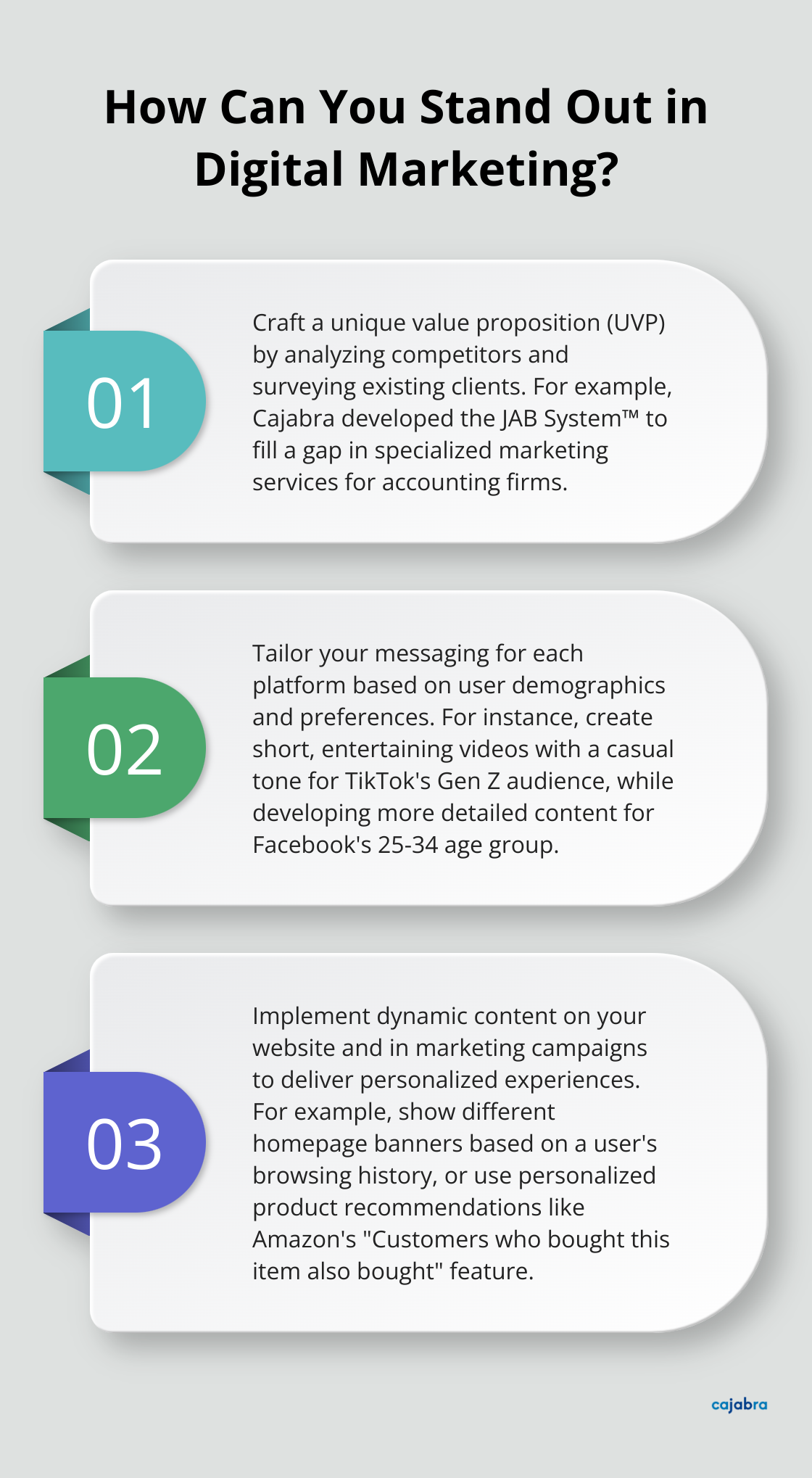
A multi-channel approach tailored to each platform maximizes reach and impact in today's digital landscape. Bridging online and offline messaging creates a seamless customer experience, reinforcing brand identity at every touchpoint. Personalization takes messaging strategies to new heights, significantly increasing engagement and conversions through audience segmentation and dynamic content.
At Cajabra, we apply these messaging strategy examples to help accounting firms transform their businesses. Our specialized marketing services assist accountants in moving from overlooked to overbooked in just 90 days. We encourage you to implement these effective strategies in your own business, starting with an evaluation of your current approach and gradually incorporating these techniques.
